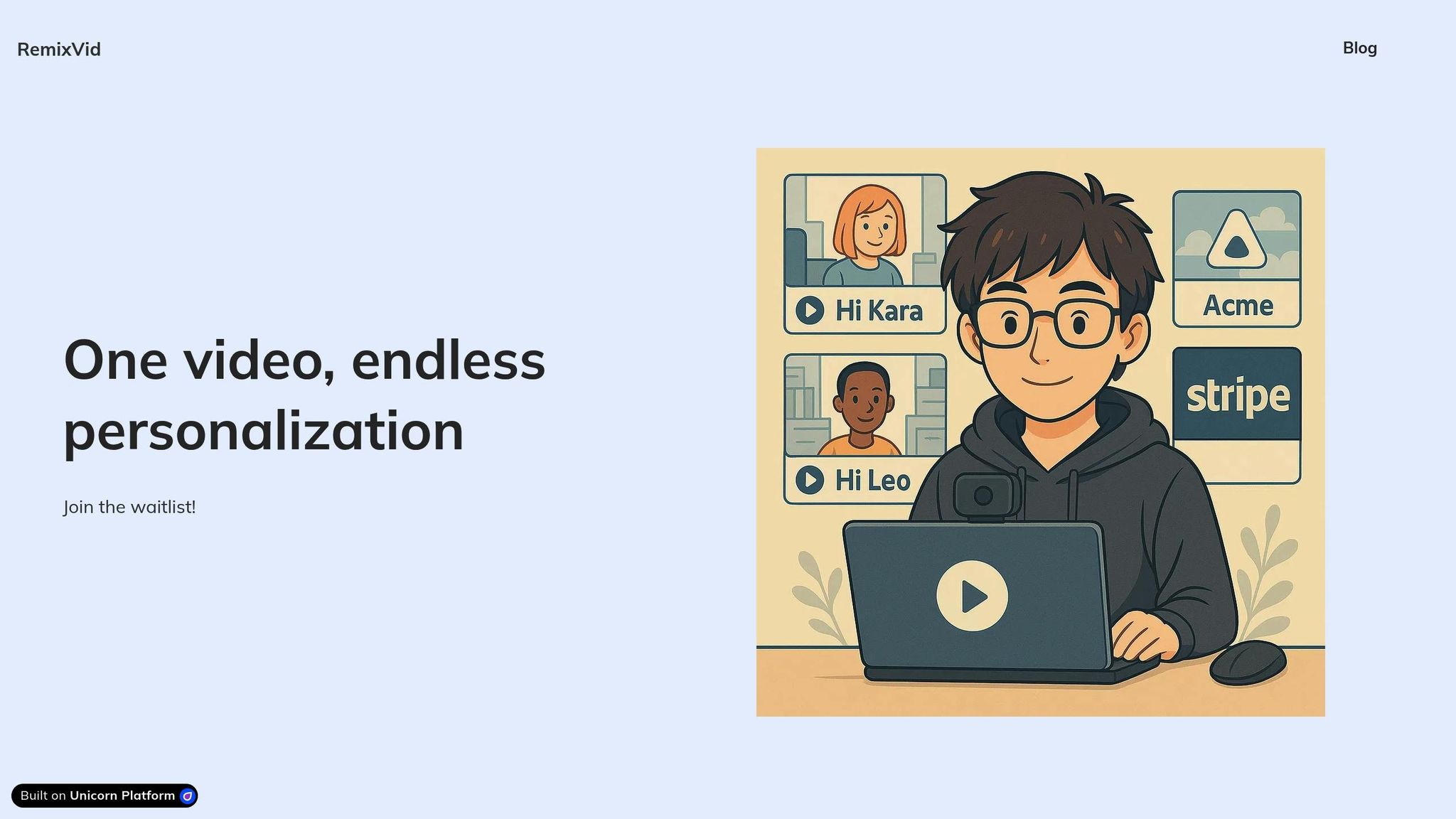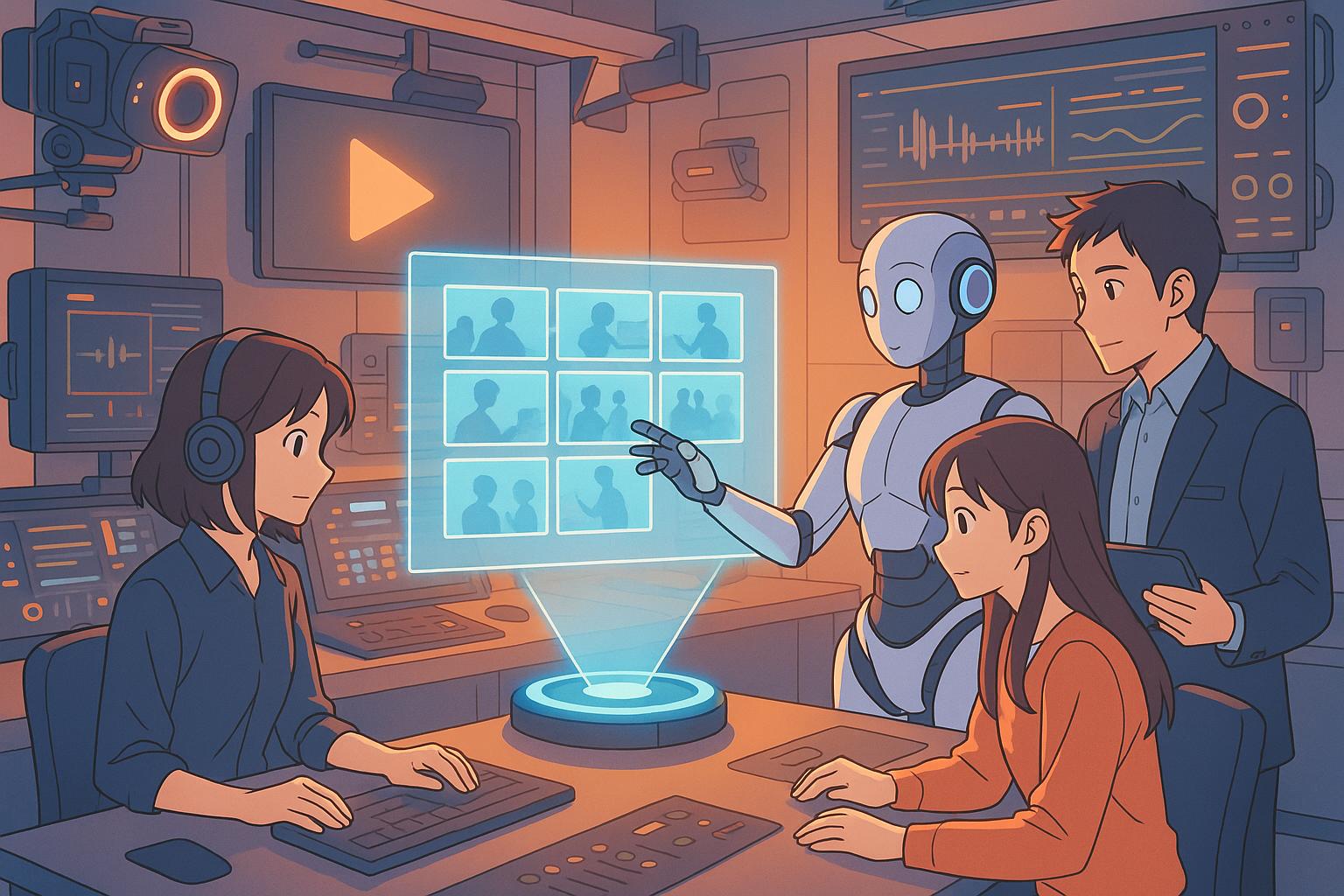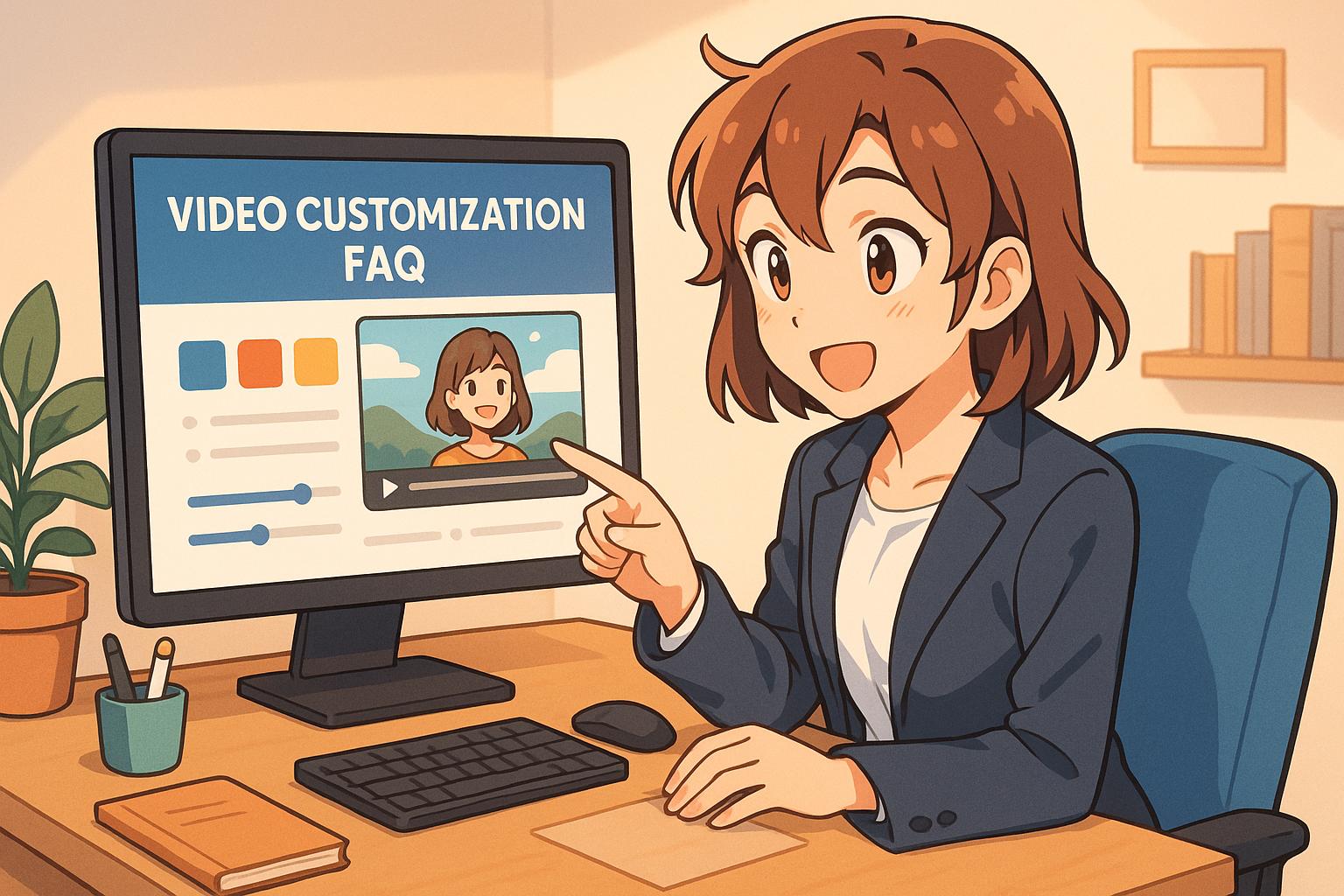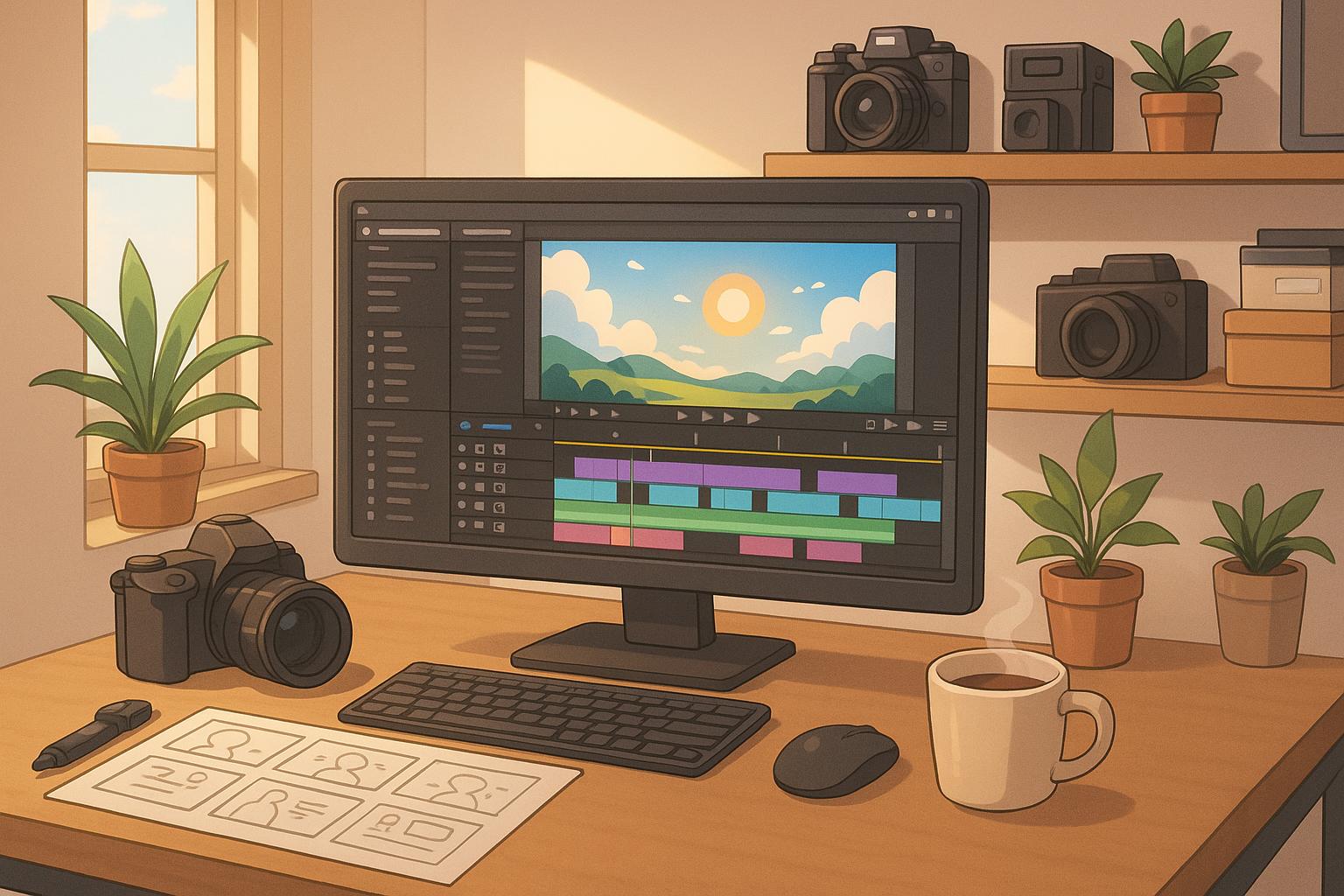AI is transforming video personalization by analyzing viewer data like preferences, watch history, and behavior patterns to create tailored content at scale. Personalized videos boost engagement, conversions, and customer satisfaction. For example, Netflix reports that 80% of watched content comes from AI-driven recommendations, while businesses using personalized videos see 5–8x higher ROI. Tools like RemixVid simplify the process, enabling companies to produce thousands of customized videos efficiently. Key benefits include higher click-through rates, increased retention, and improved sales. Tracking metrics like conversion rates, engagement, and satisfaction ensures ongoing optimization and success.
AI-powered Personalization for Video Outreach
How AI Analytics Improves Viewer Personalization
AI analytics has proven to be a game-changer for marketing and sales, boosting marketing effectiveness by 30% and driving sales up by 20%. By analyzing user behavior, AI builds detailed profiles that enable highly targeted video experiences. What makes AI analytics so powerful is its ability to continuously learn and adapt. Businesses using predictive analytics tools are 2.9 times more likely to surpass industry benchmarks for revenue growth acceleration. This advantage stems from AI’s knack for spotting subtle patterns in viewer behavior that might escape human analysts, paving the way for more precise personalization strategies. These insights highlight how data-driven preferences can create custom viewing journeys.
Using Viewer Data to Learn Preferences
AI systems excel at collecting and analyzing data streams to uncover what viewers truly want. They dive deep into metrics like watch time, click-through rates, and points where viewers drop off. Beyond that, AI looks at audience demographics, offering insights into who’s watching and why.
By pulling together data from various digital sources, AI models predict the content viewers are most likely to engage with. This includes examining trends like viewing habits, purchase history, and how long users stay engaged.
Marketers using AI-powered video analytics have reported engagement increases ranging from 20% to 50%. AI doesn’t just figure out what people enjoy watching - it also pinpoints when they’re most likely to watch and how they interact with different types of content.
Take Starbucks as an example. Its predictive personalization program, powered by machine learning, suggests specific drinks to app users based on their past purchases. It even predicts orders depending on factors like time of day or weather. These insights are seamlessly integrated into their inventory management system. Similarly, AI can create tailored video experiences by analyzing individual behaviors and preferences.
Building Custom Viewing Experiences
Once AI identifies viewer preferences, it transforms raw data into personalized on-screen experiences. The technology processes viewer data in real time, delivering dynamic and adaptive content. Algorithms learn from user interactions continuously, refining personalization accuracy over time.
Research shows that 71% of consumers prefer personalized experiences, while 67% get frustrated when content feels irrelevant. AI addresses this by recommending content that aligns with individual interests and adjusting video streams to match viewer preferences. It can even add interactive elements or overlays that adapt based on how viewers engage with the content.
AI also analyzes viewer interactions within videos, rearranging sequences to maintain engagement. This enables adaptive content that updates mid-play, reacting to user interactions or external factors like location or time of day.
Personalized video content is a proven driver of results. It generates three times more conversions than standard videos. For instance, Lenovo achieved a 4.5x boost in click-through rates and a 400% increase in email opens through personalized video campaigns. Similarly, Act-On saw a 62% rise in engagement on personalized video landing pages.
The impact of AI-driven personalization extends across industries. A global fashion brand saw online sales climb by 30% thanks to personalized product videos. A travel agency increased bookings by 25% using destination-specific video ads, and a bank improved customer retention by 15% with personalized explainer videos for financial products.
Companies leveraging AI for personalization also report up to 20% higher customer satisfaction. The secret lies in AI’s ability to process massive amounts of data quickly and accurately, identifying patterns in viewer preferences that might otherwise remain hidden.
AI Technologies That Drive Video Personalization
Several AI techniques work together to create video experiences tailored to individual viewer preferences. Below, we explore the core technologies that make this possible.
Recommendation Systems
Recommendation systems powered by AI analyze viewer behavior, ratings, and content metadata to suggest videos that align with individual tastes. These systems consider factors like what users watch, how often they replay content, and how long they stay engaged with a video. For instance, platforms like Netflix rely on these systems to drive over 80% of their content discovery. By adapting in real time to user feedback, these systems continuously refine their recommendations. This not only saves users over 1,300 hours of search time daily but also boosts customer satisfaction by 20% and increases conversion rates by 10–15%.
Natural Language Processing and Computer Vision
Natural Language Processing (NLP) and computer vision work hand-in-hand to analyze both the textual and visual aspects of video content, enhancing its relevance for viewers. NLP deciphers language to assess reviews, extract keywords, and evaluate sentiment. At the same time, computer vision identifies visual patterns, categorizes content, and optimizes thumbnail selection to catch the viewer’s eye. These technologies can even transform verbal or written requests into digital images, improving accessibility by converting sign language into text or speech. Streaming platforms use these tools to analyze user reviews and video frames, with Netflix reporting that AI-driven recommendations account for up to 80% of viewer activity and save the company approximately $1 billion annually in customer retention costs.
Sentiment and Emotion Analysis
Sentiment and emotion analysis take personalization a step further by examining viewers' emotional responses. This technology assesses emotions expressed in text, speech, or visual cues, combining visual and auditory data for a more complete understanding. By gauging emotional reactions, media companies can fine-tune content to better connect with their audience. Research shows that customers with an emotional connection to content are 52% more valuable than those who are simply satisfied. Netflix, for example, uses sentiment analysis to evaluate audience reactions by analyzing facial expressions and body language (with consent), which helps improve its content recommendations. Personalized videos have been shown to be up to 116% more effective than generic ones, with some campaigns reporting a 500% increase in direct mail response rates and stronger product engagement.
sbb-itb-1b61896
Using AI Personalization with RemixVid

Creating personalized video content can be a daunting task, but RemixVid makes it manageable for businesses of all sizes. By tapping into viewer behavior data, RemixVid transforms AI insights into scalable, tailored video content. The platform’s user-friendly interface ensures that even those without technical expertise can produce personalized videos efficiently. This seamless transition from AI analytics to practical application highlights RemixVid's ability to simplify the personalization process.
Making the Personalization Process Easier
RemixVid streamlines the complex task of video personalization with its AI-powered workflow. It starts with users uploading their base video content in widely supported formats. Once uploaded, the platform transcribes the audio into text, laying the groundwork for customization.
Next, users define placeholders within the transcript - such as a recipient’s name or company - to pinpoint areas for personalization. These placeholders allow for natural, conversational customization, ensuring the final video feels authentic.
"AI personalization refers to the use of artificial intelligence (AI) to tailor messaging, product recommendations, and services to individual users." - Molly Hayes, Content Writer, IBM Consulting
After placeholders are set, RemixVid uses AI to generate personalized versions of the video by filling in the placeholders with specific data for each recipient. This automated approach eliminates the need for manual recording, significantly reducing production time while maintaining quality. The AI ensures these personalized elements blend seamlessly into the video, creating a polished and natural result.
Additionally, RemixVid supports conditional content, meaning viewers only see segments relevant to them. This feature is particularly useful for businesses catering to diverse audiences with varying needs. By analyzing input data, the platform selects the most appropriate content for each recipient, delivering a truly tailored viewing experience.
Benefits of Using RemixVid for Video Personalization
RemixVid doesn’t just simplify the production process - it also enhances engagement and scalability. Its AI-driven approach allows businesses to create thousands of personalized videos in the time it would typically take to produce just a few. This capability is invaluable for meeting growing consumer expectations for tailored content.
The platform saves time by replacing the need for individual video recordings. Instead, marketing teams can create a single video template and let RemixVid handle the personalization. This efficiency frees up resources, enabling teams to focus on strategy and content quality. Research shows that fast-growing organizations generate 40% more revenue from personalization than slower-moving competitors, making RemixVid’s time-saving features a direct contributor to business growth.
The applications for RemixVid extend across various business functions. Sales teams use it for prospecting and follow-ups, customer success teams for onboarding and training, HR departments for recruiting, and marketing teams for targeted campaigns.
The impact on engagement is striking. Personalized videos produced with RemixVid can achieve 16 times higher click-to-open rates in email marketing compared to generic content. This boost in engagement translates into tangible business benefits, such as reducing customer acquisition costs by up to 50%.
"Recent advancements in AI technology, such as generative AI, have enhanced marketing practices by generating personalized experiences in close to real time." - Amanda Downie, Inbound Content Lead, AI Productivity & IBM Consulting
Moreover, RemixVid helps businesses respond to the rising demand for AI-enhanced experiences. With three in five consumers expressing interest in using AI tools while shopping, the platform enables companies to meet these expectations while preserving the emotional connection that video content offers. The result is a scalable solution that combines AI efficiency with the personal touch needed to strengthen customer relationships and drive growth.
Measuring Success and Improving Personalization Strategies
Creating personalized videos is just the beginning. To truly succeed, you need to track how they perform and refine your strategies based on viewer behavior. By keeping an eye on key business, engagement, satisfaction, and technical metrics, you can make sure your videos keep getting better.
Key Metrics to Track
To measure success, focus on four key metric categories: business, engagement, satisfaction, and technical. Each one sheds light on a different aspect of how well your personalization efforts are working.
Business metrics are all about the bottom line. For instance, the conversion rate tells you what percentage of viewers take the action you want - whether that's clicking a call-to-action, making a purchase, or scheduling a meeting. This directly ties your video efforts to tangible results.
Engagement metrics show how well your content grabs and holds attention. Open rates reveal how many recipients opened emails with your personalized videos. Viewing rates tell you how many clicked to watch, and completion rates indicate whether they stayed until the end. Research highlights that personalized videos can achieve viewing rates of over 67%.
Satisfaction metrics go deeper, assessing long-term impact. Metrics like Net Promoter Score (NPS) measure how likely customers are to recommend your company after viewing your content. Similarly, the Customer Satisfaction Index (CSI) gauges how well your videos meet expectations. Churn and retention rates help you understand whether your efforts are building loyalty.
Technical metrics focus on system performance. Tracking response times and error rates ensures everything runs smoothly, while demographic data and active hours provide insights into which audience segments and times drive the most engagement.
The benefits of tracking these metrics are clear. For example, just including the word "video" in an email subject line can boost open rates by 19%. Additionally, personalized user experiences have been shown to deliver five to eight times the return on marketing investment.
| Metric Category | Metrics | Why It Matters |
|---|---|---|
| Business | Conversion Rate, Revenue Impact | Connects personalization directly to ROI |
| Engagement | Open Rate, Viewing Rate, Completion Rate | Reflects content’s ability to attract and retain attention |
| Satisfaction | NPS, Customer Satisfaction, Retention | Measures relationship-building success |
| Technical | Response Time, Error Rate, Demographics | Ensures system reliability and offers audience insights |
Using Analytics for Ongoing Improvement
Analytics play a critical role in improving personalization strategies. By using AI-powered tools, you can turn data into actionable insights and refine your approach continuously.
One effective method is A/B testing, which allows you to experiment with different video elements like thumbnails, titles, length, or messaging. For example, The Thinking Traveller used Bloomreach's tools to test personalized guidance cards. Within just ten days, they saw a 33% increase in submitted inquiries from users interacting with the personalized content.
Real-time analytics are another game-changer. By monitoring viewer behavior as it happens, you can quickly identify patterns - like where viewers stop watching or which calls-to-action drive the most clicks. If you notice high completion rates but low conversions, it might be time to tweak your call-to-action.
Sentiment analysis adds an extra layer of understanding by examining comments, shares, and engagement trends. This helps you gauge how viewers feel about your content, complementing the hard numbers with deeper, qualitative insights.
Finally, continuous model refinement is essential to keeping your AI personalization effective. Regularly updating and retraining your AI models with new viewer data ensures your strategy evolves with audience preferences, creating a feedback loop that keeps your content relevant.
The potential results are impressive. Data-driven marketing videos often achieve click-through rates of 40%, with some campaigns hitting as high as 80%. For example, in 2025, CCP Games created personalized year-in-review videos for EVE Online players. By syncing gaming scenes with player data, they saw a 66% increase in visits to the EVE Online recruitment page.
To succeed with video personalization, it's essential to track multiple metrics at once instead of focusing on just one. This comprehensive approach helps you see the bigger picture and make smarter decisions to refine your strategy over time.
Conclusion: The Future of AI-Driven Video Personalization
AI-driven video personalization is changing the way businesses connect with their audiences, using tools like advanced analytics, machine learning, and real-time data to create experiences tailored to each viewer's preferences.
The impact of personalization is hard to ignore. Companies that excel in this area see a 40% increase in revenue. Personalized advertising can deliver up to five times more value than traditional contextual ads. On top of that, 93% of Gen Z consumers say they prefer personalized and interactive videos from brands. Meanwhile, 44% of consumers find generic communications frustrating.
New AI systems are taking personalization to the next level, offering adaptive, mid-play video updates based on user interactions. Predictive personalization allows AI to anticipate viewer responses, making it possible for businesses to create thousands of unique, customized videos.
There are already real-world examples of how this approach is delivering results. Telmore, a Danish telecom provider, saw an 11% boost in sales using AI-driven personalization. Similarly, TSB Bank achieved a staggering 300% increase in mobile loan sales by leveraging real-time personalization. These examples highlight how AI is driving measurable success, with platforms like RemixVid leading the charge.
RemixVid simplifies the process of creating personalized video content, making it accessible to businesses of all sizes. By removing the traditional challenges of scaling personalized content, it empowers brands to deliver tailored experiences more efficiently.
Looking ahead, AI is set to enable even greater experimentation. By automatically testing and optimizing different combinations of personalized elements in real time, businesses can refine their strategies on the fly. AI is also getting smarter at understanding context and emotion, analyzing sentiment to adjust content in ways that resonate more deeply with viewers.
"Personalization is evolving from general experiences based on demographics to highly individual interactions based on unique search intent, preferences, and context. And generative AI-powered solutions can help brands deliver hyper-personalized experiences at scale, leading to significantly higher engagement and conversions."
– Paul Longo, GM of AI Ads at Microsoft Advertising
As technology advances, businesses that use AI to enhance creativity and gain deeper insights into their audiences will thrive. Tools like RemixVid, combined with robust viewer data, offer the key to creating video experiences that feel personal while meeting the demands of scale and growth.
The future of video personalization lies in building stronger, more meaningful connections with audiences through content that truly understands and adapts to their individual needs.
FAQs
How does AI identify and personalize video content based on viewer preferences?
AI takes video personalization to the next level by diving into viewer behavior and preferences through advanced algorithms. It sifts through data like watch time, clicks, engagement habits, and past viewing history to get a clear picture of what each individual enjoys. This means platforms can adjust and recommend videos that align perfectly with a viewer's unique interests.
Beyond individual preferences, AI also analyzes demographic information and larger audience trends. This helps predict which types of content will connect best with specific groups of viewers. With these insights, platforms can create a more engaging and tailored experience for everyone.
What are the key advantages of using AI for video personalization in marketing?
AI-powered video personalization brings a host of advantages for businesses. By customizing content to align with each viewer's preferences, it not only increases engagement but also improves the customer experience, creating a stronger connection between the audience and the brand.
On top of that, AI-driven analytics provide marketers with valuable insights into audience behaviors, preferences, and demographics. These insights pave the way for crafting highly tailored content, which can translate into higher conversion rates and an improved return on investment (ROI). Incorporating AI into video marketing strategies ensures campaigns are more targeted, relevant, and effective.
How does AI make video content more personalized and relevant for viewers?
AI technologies like Natural Language Processing (NLP) and computer vision are transforming how video content is tailored to individual preferences. NLP dives into the language within videos - whether it’s transcripts, captions, or user comments - to uncover what topics or themes resonate most with viewers. This insight helps platforms align their content offerings with the audience's interests more effectively.
At the same time, computer vision focuses on analyzing visual elements, such as objects, settings, or actions captured in videos. By tagging and categorizing these visuals, it streamlines content recommendations and improves how videos are organized. Together, these tools create a more personalized viewing experience, keeping audiences engaged and satisfied.


